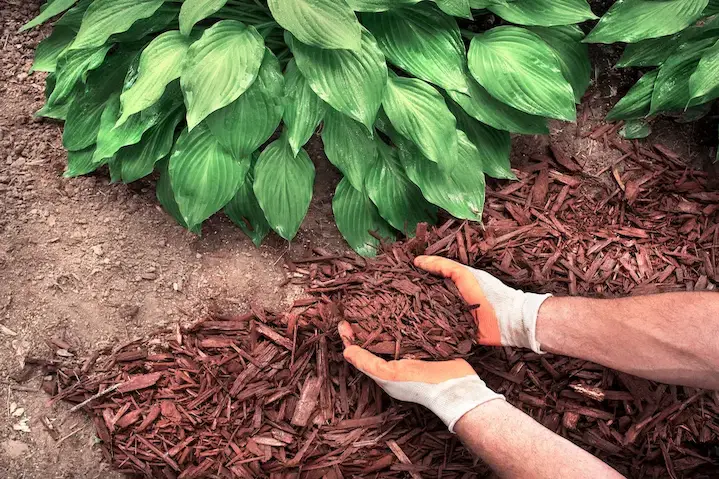
At Anderson’s Tree Care, we understand that trees and shrubs are much more than pieces of a landscape puzzle—they are essential, living parts of our ecosystem that deserve thoughtful and attentive care. Providing your trees and shrubs with nutrient-rich mulch is key to ensuring their roots receive the support they need to flourish.
Caring for trees and shrubs can be challenging, especially when faced with sudden issues like drought, pests, or disease. Exposed and compacted soil around trees can restrict root access to vital oxygen and nutrients. While frequent watering or chemical treatments may offer short-term relief, they rarely address the long-term health of your plants.
Our California-based tree care experts specialize in understanding the unique needs of local trees and shrubs. With our knowledge and high-quality organic mulch, we create the ideal conditions for your plants to grow strong and healthy, all while enhancing the beauty and vitality of your landscape.
7 Tips for Successful Mulching
Mulching may appear simple, but achieving the best results requires careful attention and proper technique. Here’s a step-by-step guide to ensure success:
- Clear the area: Remove any weeds, grass, or debris from around the base of your tree or shrub. This prevents competition for nutrients and creates a clean foundation for healthy growth.
- Inspect the roots: Examine the root collar, which is the area where the trunk flares outward at the base. If you notice any upward-growing roots, trim them gently. Ensure the root collar remains exposed and free from soil or mulch.
- Choose the right mulch: Select a mulch that complements your landscape and meets the needs of your plants. Popular options include wood chips, shredded bark, and even unique choices like cocoa shells.
- Apply the mulch: Spread a 2-4 inch layer of mulch around the base, shaping it like a “donut.” Keep the layer thinner near the trunk and gradually thicker toward the edges. For trees, extend the mulch to the drip line if possible; for shrubs, spread it just beyond their outer edges.
- Maintain space around the trunk: Leave a 2-3 inch gap between the mulch and the trunk. This prevents excessive moisture buildup that can lead to bark rot and ensures proper airflow.
- Water deeply: After applying the mulch, give the area a thorough watering. This helps the mulch settle and provides immediate hydration for the roots.
- Monitor and maintain: Check the mulch regularly to ensure it stays at the recommended depth and continues to retain moisture. Replenish as needed over time to keep your plants protected and nourished.
8 Benefits of Mulching
Mulching offers much more than just a polished look for your yard—it’s an essential practice for maintaining the health of your trees and shrubs. Here are some of the top benefits:
- Retains moisture: Mulch acts as a protective layer, reducing water evaporation and helping the soil stay moist. This is particularly beneficial during warm seasons, reducing the need for constant watering and potentially lowering water usage.
- Regulates temperature: Mulch insulates the soil, keeping it cooler in the summer and warmer in the winter. This protects sensitive roots from temperature extremes.
- Suppresses weeds: By blocking sunlight, mulch prevents weeds from sprouting, minimizing competition for valuable nutrients and water.
- Improves soil quality: Organic mulch gradually decomposes, enriching the soil with nutrients and enhancing its structure and fertility over time.
- Prevents erosion: Mulch reduces water runoff and absorbs the impact of rainfall, helping to minimize soil erosion and keep your yard stable.
- Protects roots: A layer of mulch shields exposed roots from damage caused by foot traffic or lawn equipment, keeping your plants safe.
- Boosts curb appeal: Mulch adds a clean, well-maintained appearance to your garden, elevating its overall visual appeal.
- Reduces soil compaction: Mulch keeps the soil loose and aerated, improving water infiltration and making it easier for roots to grow and thrive.
Need a Tree and Plant Healthcare Estimate?
Click below to leave your information and we will call you right back!
Ready to schedule your tree & plant care service?
Leave your information below and we will give you a call back.
*During normal business hours. After hours calls will be returned the next business day.
What Makes Mulch Better than Wood Chips?
Both options are great choices, as they offer comparable benefits like retaining soil moisture, regulating temperature, and suppressing weed growth.
Wood chips consist purely of shredded wood, while mulch is a blend of materials that could include bark, leaves, or even inorganic components such as rubber or stones. This diversity allows mulch to provide additional advantages, such as better nutrient release and enhanced moisture retention, depending on the type you select.
Your decision ultimately comes down to personal preference and your landscaping goals. Some homeowners are drawn to the rustic, natural appeal of wood chips, while others enjoy the variety of colors and textures that mulch can provide. Whichever you decide, you’ll be making a valuable investment in the health and longevity of your trees and shrubs.
Does Mulching Cause Termite Activity?
Although termites are attracted to moisture and wood, correctly applied organic mulch does not increase the risk of infestation. Termites typically prefer decaying wood over fresh bark mulch or wood chips.
Don’t let worries about termites stop you from enjoying the many benefits of mulching! While manufactured options like rubber or rocks are available, they lack the soil-enhancing qualities of organic mulch. Proper application is key—ensuring the mulch is applied at the right depth and kept away from the base of trees, shrubs, and structures helps reduce the likelihood of attracting termites.
This is where professional mulching services show their strength! At Anderson’s Tree Care, we customize our approach to meet the unique needs of your property, considering factors like soil type, drainage, and sunlight exposure. With our expertise, we ensure every tree and shrub receives the optimal care for healthy, thriving roots. Want to learn more about our plant healthcare services? We’re happy to provide all the details you need!
San Jose’s Expert Tree Mulchers
At Anderson’s Tree Care, we take pride in our deep understanding of California’s trees and shrubs. Our services go well beyond basic mulch application—we deliver personalized care designed to enhance the health and beauty of the local environment every day.
Every property is one of a kind, which is why we take the time to carefully assess yours. From soil composition and drainage to sun exposure and the unique needs of your plants, we evaluate every factor to create a customized plan that delivers outstanding results. We use top-quality organic mulches to enrich the soil and foster a thriving landscape. Additionally, we’re always here to provide expert advice, answer your questions, and support you in keeping your yard vibrant and healthy throughout the year.Give your trees and shrubs the expert, local care they deserve. Get in touch with us today, and let us help you create a healthy, beautiful landscape that you’ll enjoy for years to come!
Back to Tree and Plant HealthcareKeep Your Trees and Shrubs Healthy with Mulch in the San Jose Metro Area
Serving San Jose CA
San Jose | Fremont | Newark (CA) | Milpitas | Mountain View | Stanford | Palo Alto | East Palo Alto | Woodside | San Mateo | San Carlos
Redwood City | Los Gatos | Saratoga | Cupertino | Fruitdale | Campbell | Alamitos | Santa Clara | Coyote | Morgan Hill | San Martin | Gilroy
Home » Tree and Plant Healthcare » Keep Your Trees and Shrubs Healthy with Mulch



